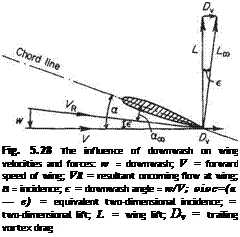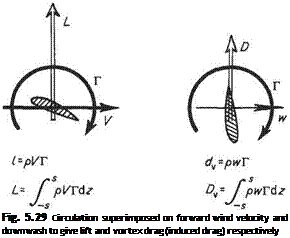The consequences of downwash – trailing vortex drag
The induced velocity at z is, in general, in a downwards direction and is sometimes called downwash. It has two very important consequences that modify the flow about the wing and alter its aerodynamic characteristics.
Firstly, the downwash that has been obtained for the particular point z is felt to a lesser extent ahead of z and to a greater extent behind (see Fig. 5.27), and has the effect of tilting the resultant oncoming flow at the wing (or anywhere else within its influence) through an angle where w is the local downwash. This reduces the effective incidence so that for the same lift as the equivalent infinite wing or two-dimensional wing at incidence ax an incidence a = аж + є is required at that section on the finite wing. This is illustrated in Fig. 5.28, which in addition shows how the two-dimensional lift Lis normal to
|
•*tp |
the resultant velocity VR and is, therefore, tilted back against the actual direction of motion of the wing V. The two-dimensional lift is resolved into the aerodynamic forces L and Dv respectively, normal to and against the direction of the forward velocity of the wing. Thus the second important consequence of downwash emerges. This is the generation of a drag force Dv. This is so important that the above sequence will be explained in an alternative way.
A section of a wing generates a circulation of strength Г. This circulation superimposed on an apparent oncoming flow velocity V produces a lift force Loc = pVT according to the Kutta-Zhukovsky theorem (4.10), which is normal to the apparent oncoming flow direction. The apparent oncoming flow felt by the wing section is the resultant of the forward velocity and the downward induced velocity arising from the trailing vortices. Thus the aerodynamic force produced by the combination of Г and V appears as a lift force L normal to the forward motion and a drag force Dv against the normal motion. This drag force is called trailing vortex drag, abbreviated to vortex drag or more commonly induced drag (see Section 1.5.7).
Considering for a moment the wing as a whole moving through air at rest at infinity, two-dimensional wing theory suggests that, taking air as being of small to negligible viscosity, the static pressure of the free stream ahead is recovered behind the wing. This means roughly that the kinetic energy induced in the flow is converted back to pressure energy and zero drag results. The existence of a thin boundary layer and narrow wake is ignored but this does not really modify the argument.
 |
In addition to this motion of the airstream, a finite wing spins the airflow near the tips into what eventually becomes two trailing vortices of considerable core size. The generation of these vortices requires a quantity of kinetic energy that is not recovered
by the wing system and that in fact is lost to the wing by being left behind. This constant expenditure of energy appears to the wing as the induced drag. In what follows, a third explanation of this important consequence of downwash will be of use. Figure 5.29 shows the two velocity components of the apparent oncoming flow superimposed on the circulation produced by the wing. The forward flow velocity produces the lift and the downwash produces the vortex drag per unit span.
Thus the lift per unit span of a finite wing (/) (or the load grading) is by the Kutta – Zhukovsky theorem:
l = pVT
the total lift being
The induced drag per unit span (dv), or the induced drag grading, again by the Kutta-Zhukovsky theorem is
![]() dv = pwT
dv = pwT
and by similar integration over the span
This expression for Dv shows conclusively that if w is zero all along the span then Dv is zero also. Clearly, if there is no trailing vorticity then there will be no induced drag. This condition arises when a wing is working under two-dimensional conditions, or if all sections are producing zero lift.
 |
As a consequence of the trailing vortex system, which is produced by the basic lifting action of a (finite span) wing, the wing characteristics are considerably modified, almost always adversely, from those of the equivalent two-dimensional wing of the same section. Equally, a wing with flow systems that more nearly approach the two-dimensional case will have better aerodynamic characteristics than one where
the end-effects are more dominant. It seems therefore that a wing that is large in the spanwise dimension, i. e. large aspect ratio, is a better wing – nearer the ideal – than a short span wing of the same section. It would thus appear that a wing of large aspect ratio will have better aerodynamic characteristics than one of the same section with a lower aspect ratio. For this reason, aircraft for which aerodynamic efficiency is paramount have wings of high aspect ratio. A good example is the glider. Both the man-made aircraft and those found in nature, such as the albatross, have wings with exceptionally high aspect ratios.
In general, the induced velocity also varies in the chordwise direction, as is evident from Eqn (5.31). In effect, the assumption of high aspect ratio, leading to Eqn (5.32), permits the chordwise variation to be neglected. Accordingly, the lifting characteristics of a section from a wing of high aspect ratio at a local angle of incidence a(z) are identical to those for a two-dimensional wing at an effective angle of incidence a(z) — є. Thus Prandtl’s theory shows how the two-dimensional aerofoil characteristics can be used to determine the lifting characteristics of wings of finite span. The calculation of the induced angle of incidence є now becomes the central problem. This poses certain difficulties because є depends on the circulation, which in turn is closely related to the lift per unit span. The problem therefore, is to some degree circular in nature which makes a simple direct approach to its solution impossible. The required solution procedure is described in Section 5.6.
Before passing to the general theory in Section 5.6, whereby the spanwise circulation distribution must be determined as part of the overall process, the much simpler inverse problem of a specified spanwise circulation distribution is considered in some detail in the next subsection. Although this is a special case it nevertheless leads to many results of practical interest. In particular, a simple quantitative result emerges that reinforces the qualitative arguments given above concerning the greater aerodynamic efficiency of wings with high aspect ratio.











